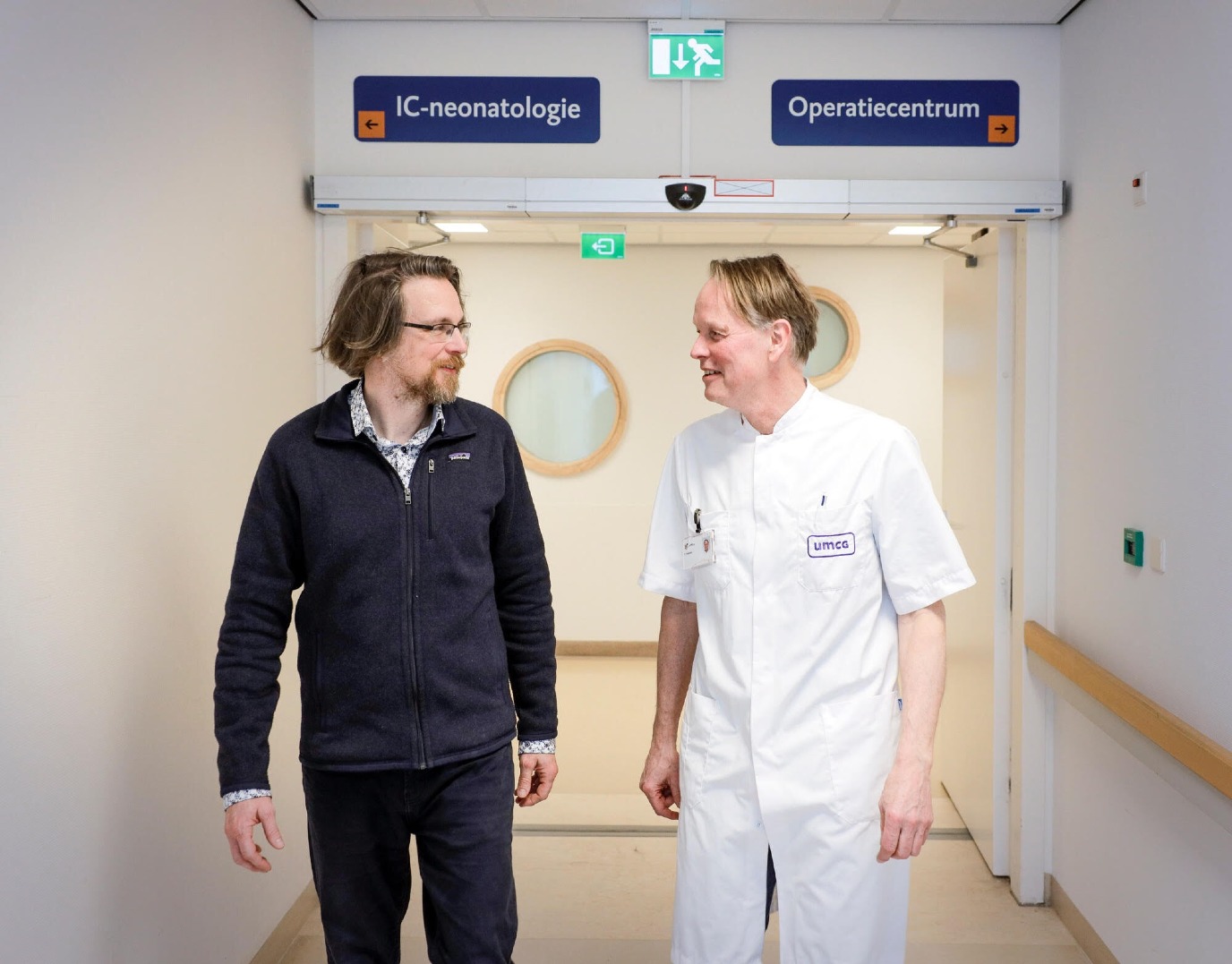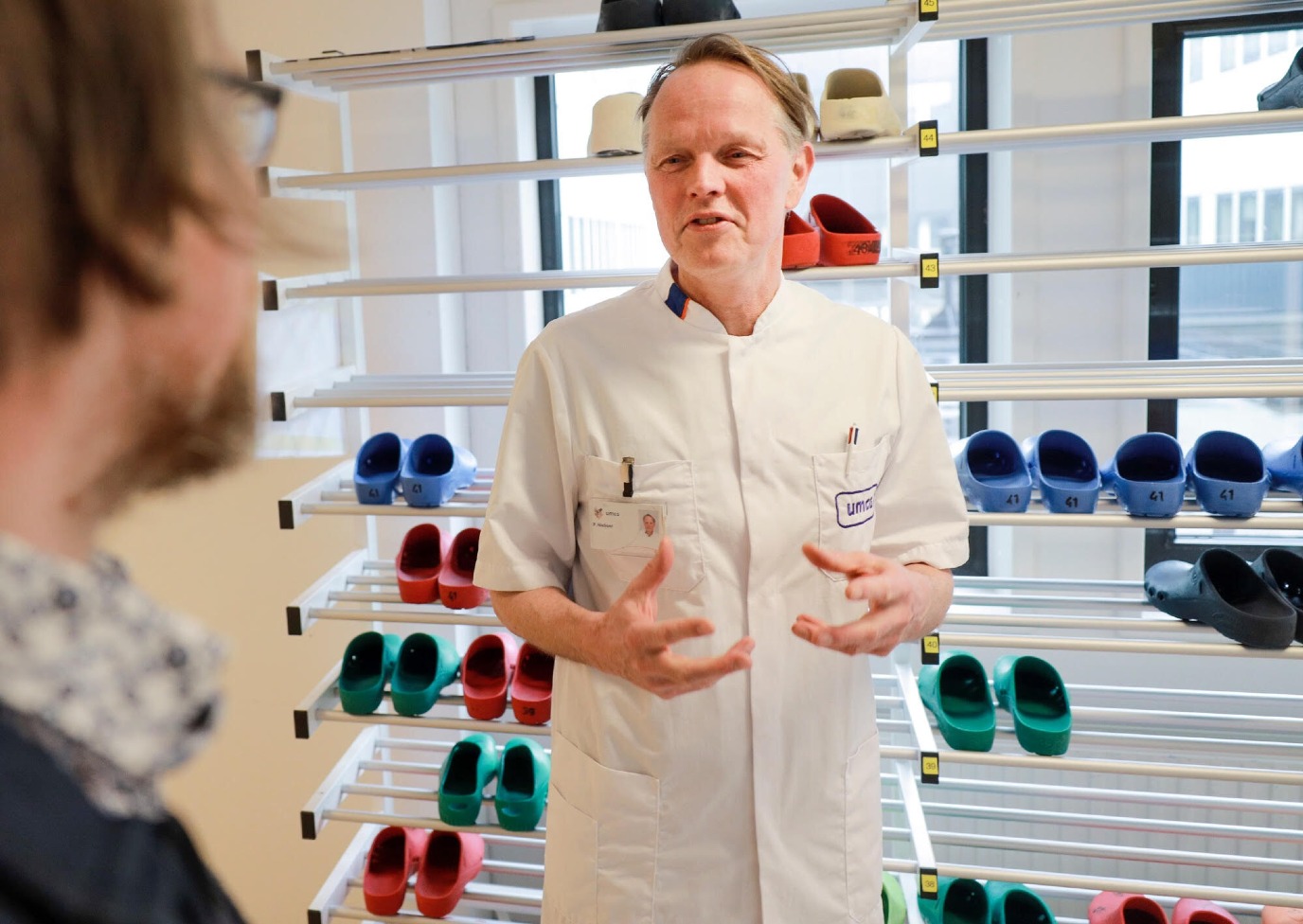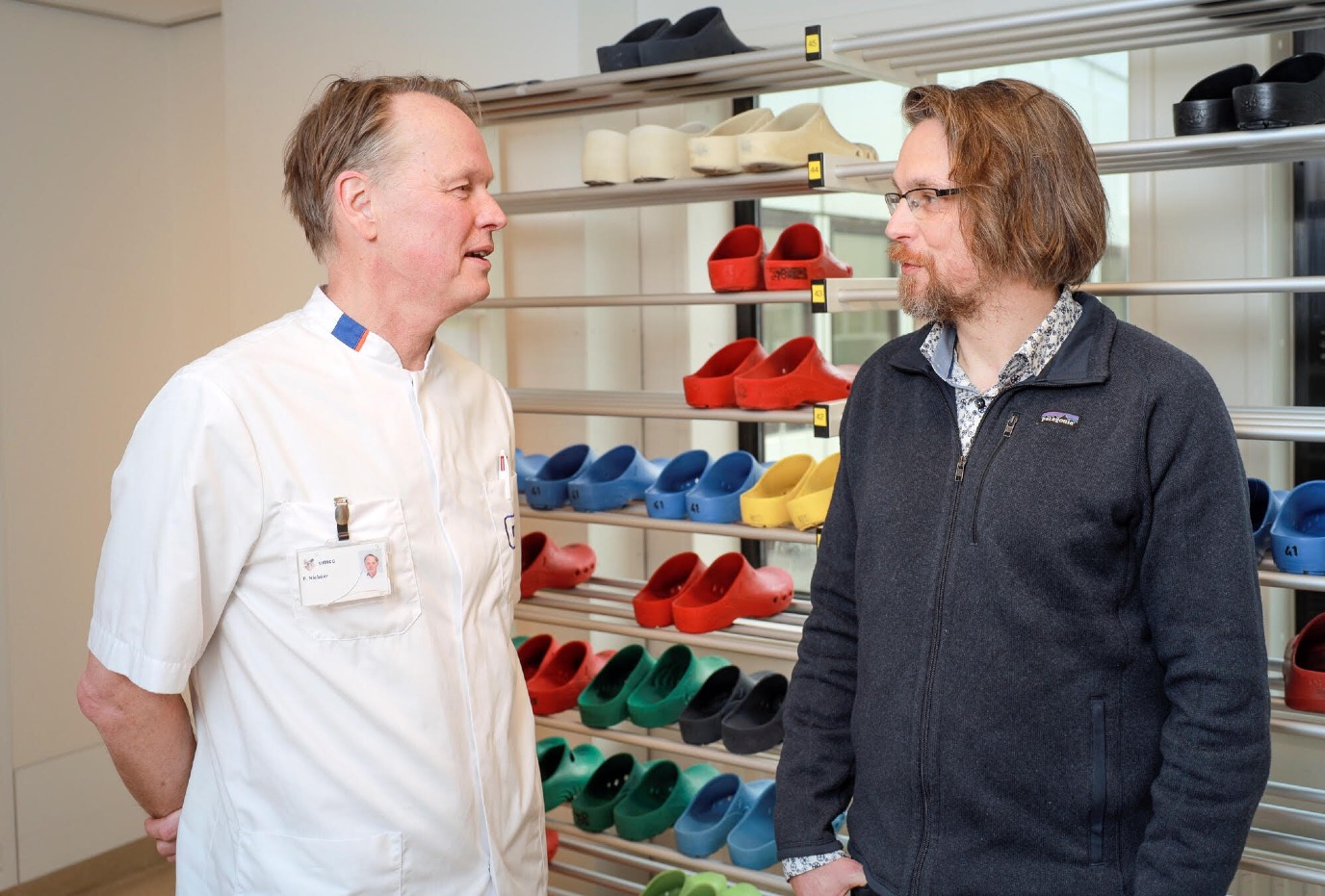Leren communiceren in de operatiekamer
De personages: een chirurg en arts in opleiding tot medisch specialist (aios). De setting: een operatiekamer, op tafel een patiënt onder narcose. De aios opereert, de chirurg heeft de rol van supervisor. Drie camera’s nemen op wat er gebeurt, met als doel de mechanismes van ‘werkplekleren’ ontrafelen. Dit is het onderzoek van een verrassend wetenschappelijk duo: hoogleraar communicatie Mike Huiskes van de RUG en traumachirurg-opleider Patrick Nieboer van het Universitair Medisch Centrum Groningen (UMCG). Huiskes: 'Dit gaat over veel meer dan wat er tijdens de operatie gezegd wordt. Het gaat over de ‘gansche mensch’.'
Tekst: Helma Erkelens / Foto’s: Henk Veenstra
'Toen ik in opleiding was tot chirurg leerde ik bij de ene supervisor heel veel en bij de ander niet', vertelt Nieboer, werkzaam bij de afdeling orthopedie van het UMCG. 'Toen ik zelf chirurgen ging opleiden merkte ik dat het coachen en begeleiden van de ene aios vanzelfsprekender ging dan met de ander.' Dat intrigeerde. Nieboer begon op de OK te filmen. Een camera op het hoofd van een supervisor, een op het hoofd van de aios en een camera die de hele setting filmde. Maar op de beelden zag hij ‘gewoon’ hoe chirurgen en aios altijd werken. Tot hij acht jaar geleden bij toeval in contact kwam met Huiskes, specialist in het analyseren van sociale interactie en verbonden aan het Center for Language and Cognition van de Faculteit der Letteren. Die zag de samenwerking helemaal zitten. 'Voor de interactieanalyticus is een operatiekamer een Walhalla. Hier werken mensen samen aan iets wat belangrijk is, waar altijd iets op het spel staat en afgerond moet worden. Iedere actie heeft consequenties. Voor mij was het een soort droom, die dataset aan filmpjes die Patrick al had.'

Alle gedrag heeft betekenis
Samen gingen ze al dat filmmateriaal bestuderen. Want waar zat dat leren nou precies in? De communicatiewetenschap bleek uiterst nuttig gereedschap te hebben om die leersituaties te analyseren. Tijdens de vele uren samen achter het beeldscherm leerde Huiskes Nieboer op de juiste manier scherp te stellen. En dít is wat ze dan bijvoorbeeld zien. Nieboer: 'Door dit onderzoek ben ik me bewuster van mijn gedrag als supervisor. Een van de dingen die ik nadrukkelijk niet doe, is praten. Ik houd mijn mond, ik wacht af. Zo geef ik de ander ruimte. Want ik weet: alles wat ik zeg heeft voor de aios betekenis. Als ik wil weten wat de aios precies doet, ga ik over operatietafel leunen. Op zo’n moment zie je, zonder dat het is afgesproken, de aios een stapje naar achter doen. Ik kijk naar die wond en trek me terug. Ik zeg niks, we opereren door.'
Interpretatiemachientjes
Huiskes: 'Wanneer je dieper kijkt, zie je hoe ze betekenis geven aan elkaars gedrag: de supervisor kijkt of de aios het goed doet, de aios geeft ruimte voor controle. De supervisor kijkt nadrukkelijk in de wond, trekt zich weer terug en zegt niks: de aios beschouwt dat als een teken van goedkeuring.'
Hij vervolgt: 'Ook lichaamstaal is belangrijk. Mensen interpreteren elkaar continu, op allerlei niveaus, overal. We zijn een soort van interpretatiemachientjes. Zie je iemand die op zijn telefoon kijkt of die de wenkbrauwen optrekt, dan zie je eigenlijk iets anders: namelijk iemand die zich verveelt of iemand die het niet met je eens is.'

Strategieën en consequenties
Via de filmpjes verzamelen ze leerstrategieën en acties aan de operatietafel. Ze brengen de variatie in kaart en bekijken de consequenties van iedere vorm. Dat vraagt om een voorbeeld. 'De aios kan bijvoorbeeld op neutrale toon ‘iets dieper’ zeggen en maakte een diepere incisie. Daarmee laat hij zien dat hij weet wat hij moet doen, dat hij een besluit heeft genomen en dat hij geen bevestiging van de supervisor nodig heeft', legt Nieboer uit. 'Hij zegt het om controleerbaar te zijn. Een andere strategie is de vraag ‘iets dieper hè?’ Zo laat de aios zien dat hij bevestiging ofwel de expertise van de supervisor nodig heeft om verder te durven. Hij kan ook zeggen ‘wat moet ik doen?’, dan heeft hij misschien geen idee.' 'In de wijze waarop de aios die hulp vraagt laat hij aan de supervisor zien hoe hij zijn eigen kennisniveau inschat', is de duiding van Huiskes. 'En andersom: de supervisor die instructie geeft, zegt daarmee eigenlijk ‘ik denk dat je het niet kan’. Daarna laat de aios in zijn reactie zien of dat zo is of niet. Het wordt continu onderhandeld.”
Leren in microstapjes
Analyse van de beelden laat zien dat al werkend leren in kleine stappen gaat. Microstapjes, zegt Nieboer. 'Die eerste kleine handeling, die eerste snee die je zet, daar begint het mee. Is die groot genoeg, is die diep genoeg? Als er overeenstemming over is gaan aios en supervisor naar de volgende stap en iedere keer weer opnieuw moeten ze het er samen over eens zijn dat het goed genoeg is om de volgende stap te zetten. Over de meeste stappen wordt niet gepraat, ze zijn al geleerd, de supervisor vertrouwt het de aios toe en observeert. Bij een hapering of aarzeling zie je dat taal een rol gaat spelen. Een vraag, een antwoord en daarna laat de supervisor de aios weer een beetje gaan. Een operatie in z’n totaliteit begeleiden is een proces van continu aftasten en checken: hoeveel invloed wil of moet ik uitoefenen, en hoeveel kan ik achteroverleunen.'

Voorspelbaar en onvoorspelbaar
Geldt dit voor alle operaties of is er verschil? Dat onderzoeken Huiskes en Nieboer met hun twee promovendi en een fiks aantal masterstudenten Communicatie aan de hand van vier verschillende medische ingrepen. Een minimaal invasieve galblaasoperatie en arthroscopie van de knie, kijkoperaties in gewone-mensentaal, waarbij de aios opereert met behulp van een operatiecamera en samen met de supervisor op een monitor volgt wat er gebeurt in het lichaam van de patiënt. Samen naar één scherm kijken geeft gelijkwaardige informatie. Dat is anders dan het ‘klassieke chirurgische handwerk’ zoals een heupvervanging of het herstellen van een gebroken pols. Daarbij komt, hoe een breuk wordt geopereerd is minder voorspelbaar, ook voor de supervisor. Nieboer: 'En waar zit dat dan in, wat komt overeen en wat niet, en wat kunnen we daarvan leren?' Nieuw is dat ze het onderzoek hebben uitgebreid naar vier andere opleidingsziekenhuizen in de regio.
Van waarde voor nu en straks
Zo zetten de dokter-opleider en de communicatieprofessor samen stappen om leren op de werkplek zichtbaar te maken. De operatiekamersetting waarin ze onderzoek doen dient als lab. De strategieën van werkplekleren die ze blootleggen bij zowel de supervisor als de aios kunnen gaan helpen om het werkplekleren in het algemeen naar een hoger niveau te tillen. In ziekenhuizen, waar op allerlei plekken door professionals wordt geleerd, én daarbuiten. Het kan zomaar zijn dat de methodiek die Huiskes en Nieboer ontwikkelen ook toepasbaar is in bijvoorbeeld een autogarage, bij de kapper, een ingenieursbureau, waar dan ook maar. Maar dat is toekomstmuziek.
Op dit moment zetten Nieboer en Huiskes de onderzoeksresultaten om in trainingen voor zorgprofessionals. Ze organiseren introductiecursussen Operatiekamerdidactiek en starten dit jaar met een structurele didactische cursus voor aios: ‘De gezel van nu is de leermeester van morgen’. Huiskes: 'Want je kunt leren hoe je een goede leerder en een goede supervisor kunt zijn. Zo’n leerklimaat op de werkplek geef je samen vorm. Je kunt leren opvatten als iets wat je overkomt maar wij leren ze dat je het ook kunt zien als een co-constructie die je kunt beïnvloeden, nu en in de rest van je professionele leven.'
Meer informatie
Meer nieuws
-
16 december 2025
Hoe AI mensen met taalstoornissen kan helpen hun spraak te vinden
-
18 november 2025
Een wifebeater? Hoe taal schadelijke ideeën versterkt
-
03 november 2025
Menopauze in perspectief: Hoe de media onze beleving beïnvloeden
